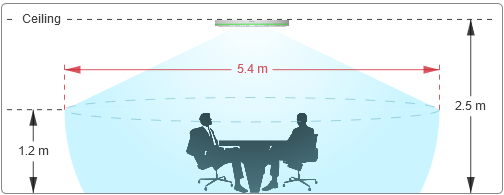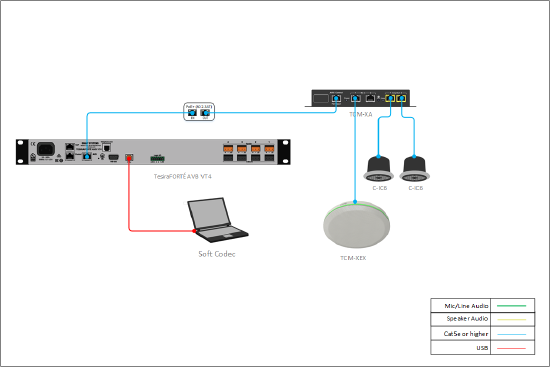Small soft-codec conference room, one Parlé ceiling mic, two speakers
This system design template shows how the Tesira beamtracking microphone TCM-XA can be used in a typical small conference room installation. Traditionally, these rooms are designed to allow room participants to host local meetings with one another using local presentation capabilities, as well as make conference calls to remote meeting participants using a PC-based soft codec.
In this example, the conference room will be equipped with a beamtracking ceiling microphone TCM-XA, placed above the center of the table, to cover the entire seating area. Meeting attendees will be automatically tracked and picked up by the ceiling microphone, which eliminates any user intervention. Tesira's Acoustic Echo Cancellation (AEC) technology and the TCM-XA beamtracker work together to deliver optimum speech quality to the far end participants. Desono I-CI6 ceiling speakers are located at suitable positions to evenly cover the room with the far-end voice or USB audio. Amplification for the speakers already comes with the TCM-XA beamtracking microphone, which makes it a genuine one-cable solution and greatly reduces the installation effort.
Room design
Room Functionality Scope:
- Ceiling microphone with beamtracking technology
- USB connection to local PC for soft codec
- 2 low impedance ceiling speakers for playback of voice signals (soft codec, USB)
Equipment list
Below is the list of Biamp equipment used in this project:
- 1 - TesiraFORTÉ AVB VT4 4 mic/line level inputs with AEC; 4 mic/line level outputs with integrated VoIP, POTS, and USB audio
- 1 - Tesira TCM-XA AVB beamtracking ceiling microphone with built-in 2-CH amplifier providing 2x 40 Watts burst power
- 2 - Desono C-IC6 Wide coverage ceiling speakers (dispersion angle of 130°) optimized for voice reproduction
Note that a non-Biamp equipment is required: a PoE+ injector.
System configuration
The example file for this system design template is set up with all the audio I/O, processing, and control points required, and is ready to load to the system and begin setting up the room gain structure and EQing. In the file, the matrix routing is already in place to support the room design requirements. One AEC processing channel on the TesiraFORTÉ AVB VT4 will be occupied by the TCM-XA microphone. No analog outputs will be required in this setup, as the speakers are being connected to the TCM-XA amplifier, represented as a separate two channel output block.
To support the conferencing needs of the space, the microphone signal is routed to the USB output. USB initialization in the file has been setup to support a 1x1 audio configuration with computer AEC disabled for the PC connection. All AEC references have been made in the matrix mixer for proper echo cancelation of conferencing sources. The file's Equipment Table is populated with proper hardware to match the layout, but will need to have serial numbers and proxy host assignments added before loading the file to system.
The .zip file below contains the example Tesira configuration files for this conference room application.
Networking details
This conference room application will make use of single-cable AVB connection between the TesiraFORTÉ DSP and the TCM-XA. A regular Cat.5e (or better) peer-to-peer connection between the two devices will connect audio, control and power altogether. In regards to cable types and lengths, the common rules to Ethernet cabling do apply. As per factory default settings, the devices will look out for a DHCP server on the network or, in its absence, will self-assign a Zeroconf address. Static IP addresses may be assigned if desired, but make sure to change the remote devices first and the Proxy device (in this case the TesiraFORTÉ) last. For a more detailed guide on how to implement in a larger range of network applications, it would be helpful to reference our Tesira Network Infrastructure article.
Setup Requirements:
- 802.3at (Class 4) PoE+ injector for powering the TCM-XA (unless an AVB switch is used, providing PoE+ power).
- Note that the TCM-XA uses Layer 2 AVB for audio and control data, IP address setup is not required.
After these control and AVB network setup steps are complete, you will now be ready to send your compiled system configuration to the hardware.
Microphone and speaker placement
The room
Arguably the single most important element in a conference system is the room itself. A noisy and reverberant room will generally sound awful for conferencing. A properly designed room with controlled reverberation and low noise floor will generally sound good for conferencing.
The importance of creating a controlled acoustic environment cannot be overstated. It is important to make the room as quiet as possible (lower noise floor) and minimize reverberance (shorter RT60) in preparation for installing the conferencing system. When properly applied, soundproofing and acoustic treatments will yield dramatic improvements in performance for most rooms.
Microphone placement
Even though the TCM-XA beamtracking microphone uses state of the art technology to track a person's voice, while reducing unwanted background noise, the laws of physics can't be ignored when deciding on the right placement of a microphone. A good signal-to-noise ratio is key in every part of the audio signal chain and for a typical microphone pickup scenario, this translates to avoiding large distances between the mic and the talker. The Parlé ceiling microphone calculator will help to find the right mic distribution for the expected coverage area. Here are a few more tips to an ideal microphone placement:
person's voice, while reducing unwanted background noise, the laws of physics can't be ignored when deciding on the right placement of a microphone. A good signal-to-noise ratio is key in every part of the audio signal chain and for a typical microphone pickup scenario, this translates to avoiding large distances between the mic and the talker. The Parlé ceiling microphone calculator will help to find the right mic distribution for the expected coverage area. Here are a few more tips to an ideal microphone placement:
- Keep the distance to the talker as short as possible.
- Keep the distance to the ceiling speakers as high as possible.
- Stay away from noise sources like projector fans and air vents.
- Place the mic in front of the talker, not above nor behind them.
Speaker placement
Placing speakers in a room can be as equally critical as finding the right spot for a microphone. An ideal positioning of multiple ceiling speakers will achieve an even SPL coverage and a good speech intelligibility across the entire room. In order to get a better sense on how much SPL the speaker of choice is able to produce with the given power of our TCM-XA amplifier, the Amplifier Power Calculator will provide some answers. In addition to that, a speaker simulation software might be able to predict the expected in-room STI values.
In this example, the speakers are not being used for voice-lift or similar live speech reinforcement, hence gain before feedback doesn't have to be considered. Still, avoiding short distances between the speakers (far-end audio) and the microphone will help to improve the AEC performance.
Audio setup
- Follow Gain Structure best practices to set input and output levels of microphones and sources. Input and output gain levels have been left at default settings for integration flexibility of the file. Input and Output metering has been added to assist with setting gain structure within the file. Additional meters can be added to the file as required to allow for additional detail at point along the signal path.
- Connect USB to PC for soft codec integration if required. Reference the USB interface setup document if needed.
- Reference AEC best practices documentation and begin to do some test calls with the system. ERL values between 0dB and +15dB are optimal.
- Level and mute controls have been added to the file pre and post matrix mixer. These are added for flexibility to meet the design criteria and tastes of the client or integrator. These level controls have been left with their default maximum and minimum values in place, but can be adjusted to fit the needs of the space.
- Uber Filters have been added to all signal paths to allow for any additional equalization as needed to sources. It is recommended to use the advanced filters section of the AEC channel processing block for any high pass filtering needed on conference table microphone inputs. Additional filtering or dynamics blocks may be added or changed as needed to achieve the desired results in the file.
- Changes to matrix mixer can be made as needed to allow for appropriate sources to feed the speakers to fit the design application.
Control integration
The example Tesira configuration file for this application has been set up to allow third-party control systems to easily control the Tesira system. There are control points for Level, Mute, and Mic Logic already in place to allow for you to use as it as-is, or add to as needed to suit the needs of the client. Control points within the file have been noted with an additional text box showing their default instance ID tag. These tags can be changed as needed to suit the programmer workflow or standardization.


